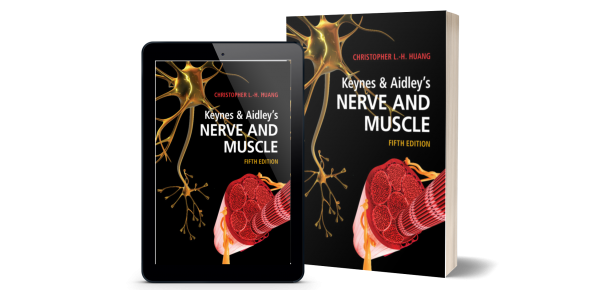
“The roads that lead man to knowledge are as wondrous as that knowledge itself.”
― Arthur Koestler (1959). The Sleepwalkers: A History of Man’s Changing Vision of the Universe. London: Hutchinson.
In biology, the initiation and execution of movement form the substrate of all action fundamental particularly to animal life. The recently published Cambridge University Press title Keynes and Aidley’s Nerve and Muscle, 5E captures the central regulatory and executive biological structures bringing about voluntary movement, the heartbeat, and vascular and gastrointestinal motility. The field of study has accordingly attracted much scientific and medical investigation.
Both early pioneering, and recent and current work, have yielded growing areas of study extending from the molecular, through the cellular, to the systems levels. Its inclusion appropriately provides an integral and central part of, and at times an introduction to, widespread medical and biology courses. Keynes and Aidley’s Nerve and Muscle narrates its story from the initial pioneering physiological investigations to our modern analysis clarified through interdisciplinary application of scientific experimentation and analysis. Here, an appreciation of the biological structures and molecules staging the drama is only a start to such understanding. It only furnishes a catalogue of anatomical and biochemical information without analysis of the dynamics of their respective physiological actions and interactions. It is the latter that underly the functional events of greater or lesser complexity, furnishing their underlying mechanisms. These then inform the prediction of outcomes and suggest means for their modification, yielding the practical benefits translatable from biological scientific discovery.
Keynes and Aidley’s Nerve and Muscle represents a scientific area in which such correlations between structural and dynamic aspects are particularly intricate and close. Their understanding is further intimately related to the experimental physiological strategies, and their interpretation, that sought their clarification. Successive contributions in this field thus form an interlocked narrative, each step logically prompting the next inquiry. What emerges is a coherent survey of the workings of nerve, its activation of muscle, and the triggering and contractile events leading to movement. Together these also make it an effective introduction to the remaining physiological sciences, from which come the capacity to both conduct meaningful scientific inquiry and apply its outcomes, including its medical applications.
These relationships, as opposed to mere accumulation of factual knowledge, cannot emerge merely from impersonal didactic accounts on molecular and body components, however exhaustive, within large University lecture rooms or electronic presentations. The student needs dialogue and direct encounters with those who had developed or are applying the subject at hand. To replicate this, a book should then present not only concepts and facts, established or under assessment, but also discuss and evaluate the evidence from current and past workers in the field upon which they were based. The precepts and principles of science are inseparable from the explorations and their interpretation from which they came. These in turn point out future directions for scientific inquiry or their applications. Scientific inquiry and application are incomplete without both: theory without practice is futile; practice without theory is blind.
Latest Comments
Have your say!